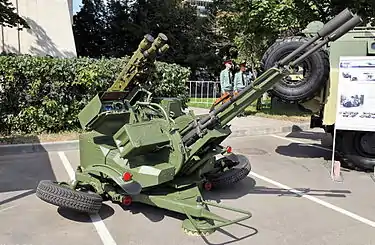ZU-23-2
The ZU-23-2, also known as ZU-23, is a Soviet towed 23 mm anti-aircraft twin-barreled autocannon. ZU stands for Zenitnaya Ustanovka (Russian: Зенитная Установка) – anti-aircraft mount. The GRAU index is 2A13.[6]
Development history
The ZU-23-2 was developed in the late 1950s. It was designed to engage low-flying targets at a range of 2.5 km as well as armoured vehicles at a range of two kilometres and for direct defence of troops and strategic locations against air assault usually conducted by helicopters and low-flying airplanes.[7] In 1955, KBP presented the single-barrel ZU-1 and the twin-barrel ZU-14. While the former was eventually dropped, the ZU-14 was selected and, after some modifications, entered series production.
In the Soviet Union, some 140,000 units were produced. The ZU-23 has also been produced under licence by Bulgaria,[8] Poland, Egypt[9] and the People's Republic of China.[10]
Development of this weapon into a self-propelled anti-aircraft gun (SPAAG) led to the ZSU-23-4 Shilka.
Description
The ZU-23-2 (2A13) mounts two 23 mm autocannons on a small trailer which can be converted into a stationary mount for firing the guns. While in this position the wheels are moved aside. The autocannon can be prepared for firing from the march position in 30 seconds and in emergency can be fired from the traveling position. The weapon is aimed and fired manually, with the help of the ZAP-23 optical-mechanical sight which uses manually entered target data to provide limited automatic aiming. It also has a straight-tube telescope T-3 for use against ground targets such as infantry as well as unarmored or lightly armoured vehicles. The ammo is fed by a conveyor belt from two ammunition boxes. Each of the ammunition boxes is located on the side of the twin autocannon and each carries 50 rounds. The fumes created by firing the weapon are partially removed through the side openings in the barrels.[7]
Normally, once each barrel has fired 100 rounds it becomes too hot and is therefore replaced with a spare barrel. Each weapon is normally provided with two replacement barrels as part of its standard equipment. Tulamashzavod Joint Stock Company is offering to upgrade the 2A14 guns to the 2A14M standard with a barrel life of 10,000 rounds instead of 8,000 rounds.
The cannon carriage is based on the earlier ZPU-2 anti-aircraft twin heavy machine gun, which mounted two KPV 14.5 mm heavy machine guns. ZU-23-2 can be identified by different placement of the ammunition boxes (at right angles to the gun carriage) and by muzzle flash suppressors. In another similarity to the ZPU series, single-barrel and four-barrel versions of the ZU-23 were also developed. However, these versions never entered service.
The ZU-23-2 can be towed by a number of different vehicles. In USSR and later Russia the most frequently used towing vehicles for it were GAZ-66 4x4 trucks and GAZ-69 4x4 light trucks.[7]
The weapon is known in the Finnish forces colloquially as Sergei.
Ammunition
The 23 mm AA gun utilizes the same 23x152B case as the wartime VYa aircraft autocannon. Due to different loadings and primers the ammunition is not interchangeable, however: ammunition of the anti-aircraft cannon can be identified from its steel casings, ammunition for the aircraft cannon having brass cases instead.[11] The following table lists the main characteristics of some of the available 23x152B ammunition used in 23 mm AA guns:
| Designation | Type | Projectile Weight [g] | Bursting charge [g] | Muzzle Velocity [m/s] | Description |
|---|---|---|---|---|---|
| BZT | API | 190 [12] | ? | 970 | Blunt AP steel core, with incendiary charge inside windshield cap.[12] Penetration 15 mm RHA at 1000 m range and 30 degree impact angle (from perpendicular), tracer burn time 5 seconds. |
| OFZ | HE | 184 [12] | 19 [13] | 980[12] | HE fragmentation round with nose fuzes incorporating self-destruct mechanism.[12] |
| OFZT | HE-T | 188[12] | 13 [13] | 980[12] | HE fragmentation round with a reduced HE charge due to the space taken by the tracer; tracer burn time 5 seconds. |
| APDS-T | APDS-T | 103 | none | 1220 | A Polish sub-caliber armour-piercing round with tracer. Penetration 30 mm RHA at 1000 m range and 30 degree impact angle (from perpendicular), tracer burn time >2.5 s. |
Not only the gun itself but also the ammunition is produced in several countries. In Bulgaria, the company ARCUS Co. produces rounds and fuses for the 2A7 and 2A14 guns.[14]
Service history
The ZU-23-2 first entered service with the Soviet Army in 1960. The gun is often mounted on trucks for use in both anti-aircraft and direct fire support roles. It can also be mounted on the roof of the MT-LB multi-purpose tracked APCs. A specially modified three-legged ZU-23-2 autocannon is used as the base for the BTR-DG airborne SPAAG. Cheap, easy to operate and still effective, the ZU-23-2 is still used by the Russian Army and by more than 20 other armies.
From 1965 onwards, the Soviet Union began supplying the Democratic Republic of Vietnam with large shipments of weapons.[15] The 23 mm ZU-23-2 was, along with the 37 mm M1939, the most frequently encountered anti-aircraft gun in Vietnam. Given that 83% of the USAF losses came from ground fire, the ZU-23 was probably responsible for shooting down hundreds of aircraft.[16]
During the Soviet–Afghan War, the Soviet forces placed ZU-23-2 sets in the occupied areas to secure their positions, employing them in both the static defense and direct fire support roles. In the later Afghan Civil War, the main belligerents, the Taliban and the Northern Alliance forces also employed ZU-23-2 autocannons mounted on BMP-1 and BTR-70 APCs or GAZ-66 and ZIL-131 trucks, along with SA-7 Grail or Stinger Missiles, as their primary air-defense and direct fire support weapons.
The ZU-23-2 was extensively employed during the Lebanese Civil War, mounted on a variety of civilian and military vehicles, including M113 and BTR-152 APCs, Dodge Ram (1st generation) pickup trucks, AIL M325 Command Cars, Toyota Dyna U10-series trucks, Dodge W600 medium-duty trucks and M35A1/A2 trucks.[17] They proved very useful in urban combat, being employed in the direct fire support role by the Syrian Army, the Palestine Liberation Organization (PLO) guerrilla factions and the various Christian and Muslim Lebanese militias.[18] In late 1983, the ZU-23-2 was used on attacks against dug-in positions held by U.S. Marine ground units serving with the Multinational Force in Lebanon (MNF II). At the time, a Marine spokesman described such antipersonnel use of the weapon as a violation of the laws of war; however, writing for the Marine Corps Gazette in 1988, Maj. W. Hays Parks dismissed this allegation as incorrect.[19]
During the Gulf War of 1991, it was a favorite weapon of the Iraqi Army, albeit used more often against ground targets such as infantry and light enemy vehicles. They tended to use it more against ground targets as the ZU-23-2 is ineffective against fast-moving jet aircraft, though later on it was proven to be relatively ineffective as it inflicted few casualties throughout the war.
The ZU-23-2 also saw usage during the Georgian Civil War and at least one kill was claimed by a ZU-23-2, when Georgian forces shot down a Sukhoi Su-25 fighter-bomber jet on 4 June 1993.[20]
The ZU-23-2 has seen widespread use by both sides in the Libyan Civil War, being often mounted on technical pickup trucks.[21][22] The weapon has also been heavily used in the Syrian Civil War, being installed on pickup trucks and is credited for bringing down several Syrian Air Force helicopters.[3] Technicals equipped with ZU-23-2 autocannons have also been frequently employed against moving ground targets. During the Yemeni Civil War, ZU-23-2 autocannons are said to have engaged Saudi tanks.[3]
Variants and upgrades
Soviet Union/Russian Federation

- ZU-23M – Upgraded variant, designed by the Nudelman Precision Engineering Design Bureau (KB Tochmash). Has new targeting system (which includes laser rangefinder, television channel, optical mechanic device, can be reinforced with thermo location channel and a television system for usage at night) and electromechanic turn system. Optionally, the mount can be fitted with two short-range air-defence missiles, such as the 9M32M "Strela-2M" or the 9M39 "Igla".[23][24]
- ZU-23M1 – This is the current model, developed by Open Joint Stock Company Podolsky Electromechanical Plant of Special Engineering "PEMZ Spetsmash" and Closed Joint Stock Company "NTC Elins" and offered by Rosoboronexport. Like the ZU-23M, it has an upgraded fire control system and can optionally be fitted with two launchers for the "Igla" series missile, usually the 9M342 "Igla-S".[25]
- The complete air-defence gun/missile system is called ZU-23/ZOM1 (often erroneously called "ZU-23/30M1"). It consists of the "missile-gun firing module" (strel'bovoj modul) ZU-23/ZOM1-SM; the "missile-launching module" (puskovoj modul) ZU-23/ZOM1-PM armed with four 9M333 "Strela-10" missiles; a remote control module (modul distantsionnogo upravleniya) ZU-23/ZOM1-MU and a portable generator AB-1. Depending on the wishes of the client, the system can be delivered without the -SM module (ZU-23/ZOM1-1), without the -PM module (ZU-23/ZOM1-2), without the remote control (ZU-23/ZOM1-3), or without -PM and -MU modules (ZU-23/ZOM1-4).[26] The latter can be carried by the Samum 4x4 wheeled chassis vehicle and the first export contract has been signed as of early 2019.[27]
Poland

- ZU-23-2 – Polish designation for basic gun variant. Built under license in Zakłady Mechaniczne "Tarnów" S.A. (ZMT Tarnów) since 1972.[28]
- ZUR-23-2S "Jod" – Polish variant with electro-optical sight GP-1R and twin launcher for "Strela-2M" missiles, used from 1988[28] (picture).
- ZUR 23-2KG Jodek-G – Development of ZUR-23-2S with more advanced reflex sight CKE-2 (later CP-1 night-and-day sight with laser rangefinder), electromechanic gun turn system and twin launcher for "Grom" missiles, produced from 2002 (pictures)[28]
- ZUR-23-2 kg-I – Improved export version for Indonesia with CKE-2I sight.
- TR-23-2 – Training simulator version of the ZUR-23-2 kg-I. The set consists of an instructor's station and a gunner's station (a modified "artillery-missile unit" with the sight replaced by a computer station). Both stations are linked by a wireless network.[29]
- Kobra – Polish short-range modular air-defense system. A typical battery consists of up to 6 guns (for example ZUR-23-2 kg), up to 6 Poprad systems, a WD-95 command post and a Radwar MMSR radar.[30]
- ZUR 23-2KG Jodek-G – Development of ZUR-23-2S with more advanced reflex sight CKE-2 (later CP-1 night-and-day sight with laser rangefinder), electromechanic gun turn system and twin launcher for "Grom" missiles, produced from 2002 (pictures)[28]
- ZU-23-2M "Wróbel" – Polish naval version of ZU-23-2, hydraulically powered, produced from 1979.[28]
- ZU-23-2MR "Wróbel-II" – Polish naval version of ZUR-23-2S, with Strela-2M missiles and water-cooled barrels, produced from 1986[28][31] (picture).
- "Hibneryt" – A ZU-23-2 family gun mounted on specially modified Star 266 truck, truck is fitted with additional ammunition for the gun and modified electrical installation to power guns electromechanic turn system (gun can also work from batteries).
- ZUR-23-2S "Jod" – Polish variant with electro-optical sight GP-1R and twin launcher for "Strela-2M" missiles, used from 1988[28] (picture).
ZUR 23-2SP Jodek-SP – Version used in PSRA Pilica VSHORAD system.[32]
Czech Republic
- ZU-23-2M2 Vlara – Field upgrade modernization kit. (picture).
Slovak Republic
Egypt
- ZU 23-M – Licence version of the ZU-23. It is also known as SH-23M and is produced by Abu Zaabal Engineering Industries (Factory 100).[9]
- Nile 23 – Self-propelled version on the tracked M113. A system consists of the combat vehicle with ZU 23-M guns and surface-to-air missiles Saqr Eye, and a tracker vehicle, also based on the M113.[35][36]
- Sinai 23 – Similar to the Nile 23, with two Zu-23 guns and six Saqr-Eye missiles mounted on a TA-23E turret and fitted with a RA-20S E-band radar. Developed by Dassault and selected by Egypt in preference to Nile 23, entering service by 1992.[37] Instead of the Saqr Eye, FIM-92 Stinger missiles can be used.[38]
Finland
- 23 ItK 95 – Finnish upgrade of the original 23 ItK 61, designed by Instrumentointi Oy and Vammas Oy. The upgrade adds gyro-stabilization to the gun, along with an APU and a laser range finder.[23]
- SAKO 23 mm/87 – a navalized modernization used by the Finnish Navy. Variants are the 23 M74, the 23 M77, the 23 M80 and the 23 M85. The guns can be removed from M85 carriage and replaced with six Mistral surface-to-air missiles.[39]
China
- Type 85/YW 306 – Reverse-engineered copy of the ZU-23-2, made by NORINCO.[10] Initially it was offered for export as the G-AA-01.[40] It is referred to as Type 85 gun by some sources.
- Giant Bow – Also known as Shengong (Deity Bow, 神弓). This is the name of an air-defense system, which consists of up to eight Type 85 guns and a battery command vehicle (BCV).[10]
- Giant Bow II a.k.a. Shengong-II – This is a more modern version of the Giant Bow and is offered for export since 2005. Apart from the 23 mm guns, it also comprises TY-90 missile launchers and a 3D radar.[10]
- Type 87 – Upgraded version with twin 25 mm guns for 25x183B ammunition such as the PG87. After a failed initial design, an improved design was developed in 1979 and ready for evaluation in 1984. The Type 87 gun was accepted for service in 1987. It has the same layout as the original model and consists of two automatic, recoil-operated cannons, a two-wheel cartridge, a Type 86 infrared tracking sight and two 40-round ammunition magazines. The Type 87 fires in either single shot or burst mode, with a cyclic rate of fire of 600~700 rounds/min and has a muzzle velocity of 1,050 m/s.[41]
- PGZ95 – self-propelled version of the Type 87.
General characteristics
- Overall dimensions in firing position
- Length: 4.57 m (15 ft)
- Width: 2.88 m (9.44 ft)
- Height: 1.22 m (4 ft)
- Weight: 0.95 tonnes (2,094 lbs)
- Armament: two 2A14 Afanasyev-Yakushev 23x152mm (.90 in) autocannons
- Barrel length: 2 m (6.5 ft)/ 87.3 calibers
- Muzzle velocity: 970 m/s (3,182 ft/s)
- Projectile weight: 186 g (6.27 oz)
- Rate of fire
- Cyclic: 2,000 rounds per minute
- Practical: 400 rounds per minute
- Effective range: 2-2.5 km (1.24-1.55 mi)
- Effective altitude: 1,500-2,000 m (4,921-6,562 ft)
- Crew: 6
Operators
 Afghanistan
Afghanistan Algeria – 100[43]
Algeria – 100[43] Angola[44]
Angola[44] Armenia[45]
Armenia[45] Azerbaijan
Azerbaijan
 Bangladesh
Bangladesh Belarus – 128
Belarus – 128 Bosnia-Herzegovina – 29[47]
Bosnia-Herzegovina – 29[47] Bulgaria[48]
Bulgaria[48] Burundi[49]
Burundi[49] Cambodia
Cambodia Cape Verde – 12[50]
Cape Verde – 12[50] Chad[51][52]
Chad[51][52] China – Type 85, Type 87 (25*183 mmB, not 23*152 mm)
China – Type 85, Type 87 (25*183 mmB, not 23*152 mm) Cuba[53]
Cuba[53] Djibouti – 5[54]
Djibouti – 5[54] Ecuador[55] – Type 80<
Ecuador[55] – Type 80< Egypt – 220 ZU-23-2 and more than 81 self-propelled Sinai-23[56]
Egypt – 220 ZU-23-2 and more than 81 self-propelled Sinai-23[56] Eritrea[57]
Eritrea[57] Estonia – 198, some mounted on MAN 4520 6x6 trucks.
Estonia – 198, some mounted on MAN 4520 6x6 trucks. Ethiopia[58]
Ethiopia[58] Finland – 1,100
Finland – 1,100 Gabon – 24[59]
Gabon – 24[59] Greece - 503[60]
Greece - 503[60] Georgia – About 200, 40 mounted on MT-LB, some on ZIL-131 trucks and navy Vessels. Applied to RWS.
Georgia – About 200, 40 mounted on MT-LB, some on ZIL-131 trucks and navy Vessels. Applied to RWS.
 Ghana – 4[62]
Ghana – 4[62] Guinea-Bissau – 18[63]
Guinea-Bissau – 18[63] Hungary
Hungary India – 320 towed and more truck-mounted[64]
India – 320 towed and more truck-mounted[64] Indonesia – 4 system ZUR-23-kg-I as part of the "Kobra" AD system for the TNI-AU[65] + 18 Type 80 as part of the Giant Bow II AD system for the TNI-AD[66]
Indonesia – 4 system ZUR-23-kg-I as part of the "Kobra" AD system for the TNI-AU[65] + 18 Type 80 as part of the Giant Bow II AD system for the TNI-AD[66] Iran - 300[67]
Iran - 300[67] Iraq[68]
Iraq[68]
 Israel - 150,[70] Captured from Arab Armies over the Arab-Israeli Conflict.
Israel - 150,[70] Captured from Arab Armies over the Arab-Israeli Conflict. Ivory Coast[71]
Ivory Coast[71] North Korea[72]
North Korea[72] Laos[73]
Laos[73] Latvia – 3 ZU-23-2MR Wróbel II on Imanta and Viesturs ships.
Latvia – 3 ZU-23-2MR Wróbel II on Imanta and Viesturs ships. Lebanon – 57,[74] some mounted on M113 APC's
Lebanon – 57,[74] some mounted on M113 APC's Libya – most mounted on light vehicles[75]
Libya – most mounted on light vehicles[75] Mauritania – 20[76]
Mauritania – 20[76] Morocco – 75-90[77]
Morocco – 75-90[77] Moldova – 28,[64] some mounted on BTR-D
Moldova – 28,[64] some mounted on BTR-D Mali
Mali Mongolia[78]
Mongolia[78] Mozambique – 120[79]
Mozambique – 120[79] Myanmar – 380 Type 87
Myanmar – 380 Type 87 Namibia - some South-African Zumlac[80]
Namibia - some South-African Zumlac[80] Nicaragua – 18[81]
Nicaragua – 18[81] Nigeria[82]
Nigeria[82]
 Oman - 4[83]
Oman - 4[83] Pakistan – 5,200
Pakistan – 5,200 Peru – 80[84]
Peru – 80[84] Poland – 252 ZU-23 and 72 ZUR-23-2 series[85]
Poland – 252 ZU-23 and 72 ZUR-23-2 series[85] Russia[86]
Russia[86] Sahrawi Arab Democratic Republic[1]
Sahrawi Arab Democratic Republic[1] Somalia[87]
Somalia[87]
 South Africa – Zumlac on an armoured SAMIL 100 heavy truck. Captured in Angola in the 1980s.[90] 36 in store.[91]
South Africa – Zumlac on an armoured SAMIL 100 heavy truck. Captured in Angola in the 1980s.[90] 36 in store.[91] South Sudan[92]
South Sudan[92] Sudan[93]
Sudan[93]
 Sri Lanka
Sri Lanka Syria[94]
Syria[94] Tanzania – 40[95]
Tanzania – 40[95] Uganda – 5
Uganda – 5 Ukraine[96]
Ukraine[96] United States – Testing only
United States – Testing only Venezuela – ~200[97]
Venezuela – ~200[97] Vietnam
Vietnam Yemen – 200
Yemen – 200 Zimbabwe – 45[98]
Zimbabwe – 45[98]
Former operators
 Grenada – 12
Grenada – 12 East Germany
East Germany Islamic State - at least 52
Islamic State - at least 52 Panama
Panama.svg.png.webp) Rhodesia – 12 were captured from Soviet-supplied militants during the Rhodesian Bush War.
Rhodesia – 12 were captured from Soviet-supplied militants during the Rhodesian Bush War. Soviet Union – Passed on to successor states.
Soviet Union – Passed on to successor states.
See also
- List of Russian weaponry
- Zastava M55
- ZPU
References
- Francesco Palmas (2012). "Il contenzioso del sahara occidentale fra passato e presente" (PDF). Informazioni della Difesa (in Italian). No. 4. pp. 50–59.
- "SPLA-N weapons and equipment, South Kordofan, December 2012" (PDF). HSBA Arms and Ammunition Tracing Desk. Small Arms Survey: 8. February 2013.
- Neville, Leigh (19 April 2018). Technicals: Non-Standard Tactical Vehicles from the Great Toyota War to modern Special Forces. New Vanguard 257. Osprey Publishing. p. 10. ISBN 9781472822512.
- Rebel Forces in Northern Mali: Documented weapons, ammunition and related materiel, April 2012-March 2013 (PDF) (Report). Conflict Armament Research and Small Arms Survey. April 2013.
- Foss, Christopher (1977). Jane's Pocket Book of Towed Artillery. New York: Collier. p. 221. ISBN 0-02-080600-0. OCLC 911907988.
- "Defense & Security Intelligence & Analysis: IHS Jane's – IHS". articles.janes.com. Retrieved 6 May 2018.
- "Militarium.net". militarium.net. Archived from the original on 12 June 2010. Retrieved 6 May 2018.
- "Defense & Security Intelligence & Analysis: IHS Jane's – IHS". articles.janes.com. Retrieved 6 May 2018.
- "Defense & Security Intelligence & Analysis: IHS Jane's – IHS". articles.janes.com. Retrieved 6 May 2018.
- "Defense & Security Intelligence & Analysis: IHS Jane's – IHS". articles.janes.com. Retrieved 6 May 2018.
- "Williams, Anthony G: An introduction to collecting 23-28mm cartridges. http://www.quarryhs.co.uk/collecting%2023-28mm.htm
- "Russian Ammunition Page, http://www.russianammo.org
- ORDATA: Ordnance Identification Tool, http://maic.jmu.edu/ordata
- "ARCUS Co". www.arcus-bg.com. Retrieved 6 May 2018.
- Tucker, Spencer C (2011). The Encyclopedia of the Vietnam War: A Political, Social, and Military History. ABC-CLIO. pp. 52. ISBN 9781851099603
- http://www.airforcemag.com/MagazineArchive/Pages/2013/February%202013/0213vietnam.aspx
- Neville 2018, p. 14.
- Zaloga, Steven J. (2003). Tank battles of the Mid-East Wars (2): The wars of 1973 to the present. Hong Kong: Concord Publications. p. 7. ISBN 962-361-613-9.
- Parks, Maj W. Hays (January 1988). "Killing A Myth". Marine Corps Gazette. Archived from the original on 28 February 2014. Retrieved 23 February 2014.
- "CIS region - Авиация в локальных конфликтах - www.skywar.ru". www.skywar.ru. Retrieved 6 May 2018.
- "Rebels down Libyan aircraft as world leaders discuss next move". arabianbusiness.com. Retrieved 6 May 2018.
- Neville 2018, p. 34.
- "Archived copy". Archived from the original on 14 June 2010. Retrieved 6 June 2012.CS1 maint: archived copy as title (link)
- http://testwww.janes.com/articles/International-Defence-Review-98/RUSSIA--AUTOMATIC-AIMING-FOR-ZU-23-2-LAAG.html%5B%5D
- "Defendory International 2008 034". flickr.com. Retrieved 6 May 2018.
- "Defendory International 2008 033". flickr.com. Retrieved 6 May 2018.
- https://www.armyrecognition.com/january_2019_global_defense_security_army_news_industry/pemz_from_russia_first_export_contract_for_samum_23mm_anti-aircraft_vehicle.html
- (in Polish) "Dwudziestkitrójki" z Tarnowa ["Twentythrees" from Tarnów] in: Nowa Technika Wojskowa Nr. 9/2010, p. 76-78
- http://62.129.200.244/pdf/trenazer_en.pdf
- http://www.bumar.com/dywizje_flash/admin/store/images/image-1304661693-link.pdf%5B%5D
- "Defense & Security Intelligence & Analysis: IHS Jane's – IHS". articles.janes.com. Retrieved 6 May 2018.
- "PSRA Pilica VSHORAD Very SHOrt-Range Air Defense system data | Poland Polish Army artillery vehicle and system UK | Poland Polish army military equipment UK".
- "Industry Directory". epicos.com. Retrieved 6 May 2018.
- http://www.punjlloyd.com/sites/default/files/pdf/Force%20April%20Issue%202012%5B1%5D.pdf
- "JED". jedsite.info. Archived from the original on 2 December 2013. Retrieved 6 May 2018.
- "JED". jedsite.info. Archived from the original on 2 December 2013. Retrieved 6 May 2018.
- Cullen & Foss 1992, pp. 62–63
- "JED". jedsite.info. Retrieved 6 May 2018.
- Kiiskinen, Pekka; Wahlman, Pasi (2003). Itsenäisen Suomen laivaston laivatykit 1918–2004 [The naval guns of Finland 1918–2004] (in Finnish). Helsinki: Typomic Oy. pp. 121–133. ISBN 952-91-6807-1.
- International Defence Equipment Catalogue 1988–89, page II/27
- "Archived copy". Archived from the original on 12 December 2007. Retrieved 12 December 2007.CS1 maint: archived copy as title (link)
- Administrator. "ZU-23-6 six cannons 23 mm anti-aircraft gun technical data sheet specifications pictures video". www.armyrecognition.com. Retrieved 6 May 2018.
- The Military Balance 2017, p. 368.
- The Military Balance 2017, p. 495.
- The Military Balance 2017, p. 200.
- The Military Balance 2017, p. 203.
- The Military Balance 2017, p. 95.
- The Military Balance 2017, p. 97.
- The Military Balance 2017, p. 500.
- The Military Balance 2017, p. 502.
- Darcourt, Pierre (January 1984). "Tchad: le désert des Tartares". La Gazette des armes (in French). No. 125. pp. 16–19.
- The Military Balance 2017, p. 504.
- The Military Balance 2017, p. 450.
- The Military Balance 2017, p. 509.
- The Military Balance 2017, p. 454.
- The Military Balance 2017, pp. 373-375.
- The Military Balance 2017, p. 511.
- The Military Balance 2017, p. 512.
- The Military Balance 2017, p. 513.
- The Military Balance 2017, p. 121.
- SPUTNIK (23 July 2004). "South Ossetian a self proclaimed republic in Western Georgia Armed forces and volunteers Jawa region". alamy.com. Retrieved 9 August 2017.
- The Military Balance 2017, p. 515.
- The Military Balance 2017, p. 518.
- The Military Balance 2017, p. 210.
- "Defense & Security Intelligence & Analysis: IHS Jane's – IHS". articles.janes.com. Retrieved 6 May 2018.
- http://www.adprconsult.com.my/indo-aerospace-defence.pdf
- The Military Balance 2017, pp. 377-379.
- The Military Balance 2017, p. 381.
- The Military Balance 2017, p. 564.
- The Military Balance 2017, p. 384.
- The Military Balance 2017, p. 506.
- The Military Balance 2017, p. 304.
- The Military Balance 2017, p. 310.
- The Military Balance 2017, p. 390.
- The Military Balance 2017, p. 392.
- The Military Balance 2017, p. 393.
- The Military Balance 2017, p. 395.
- The Military Balance 2017, p. 315.
- The Military Balance 2017, p. 525.
- The Military Balance 2017, p. 526.
- The Military Balance 2017, p. 464.
- The Military Balance 2017, p. 529.
- The Military Balance 2017, p. 397.
- The Military Balance 2017, p. 468.
- The Military Balance 2017, p. 145.
- The Military Balance 2017, p. 213.
- Small Arms Survey (2012). "Surveying the Battlefield: Illicit Arms In Afghanistan, Iraq, and Somalia" (PDF). Small Arms Survey 2012: Moving Targets. Cambridge University Press. p. 339. ISBN 978-0-521-19714-4.
- GAROWEONLINE (17 March 2016). "Puntland clashes enter second day in Somalia: Who's fighting whom?". Garowe Online. Retrieved 6 July 2017.
- The Military Balance 2017, p. 534.
- "Defense & Security Intelligence & Analysis: IHS Jane's – IHS". www.janes.com. Retrieved 6 May 2018.
- The Military Balance 2017, p. 536.
- The Military Balance 2017, p. 537.
- The Military Balance 2017, p. 539.
- The Military Balance 2017, p. 405.
- The Military Balance 2017, p. 541.
- The Military Balance 2017, pp. 228-230.
- The Military Balance 2017, p. 475.
- The Military Balance 2017, p. 546.
- Cullen, Tony; Foss, Christopher F., eds. (1992). Jane's Land-Based Air Defence 1992–93 (5th ed.). Coulsdon, UK: Jane's Data Division. ISBN 0-7106-0979-5.
- Koll, Christian (2009). Soviet Cannon – A Comprehensive Study of Soviet Arms and Ammunition in Calibres 12.7mm to 57mm. Austria: Koll. p. 195. ISBN 978-3-200-01445-9.
- International Institute for Strategic Studies (February 2017). The Military Balance 2017. Routlegde. ISBN 9781857439007.
- Leigh Neville, Technicals: Non-Standard Tactical Vehicles from the Great Toyota War to modern Special Forces, New Vanguard series 257, Osprey Publishing Ltd, Oxford 2018. ISBN 9781472822512
External links
| Wikimedia Commons has media related to ZU-23-2. |
